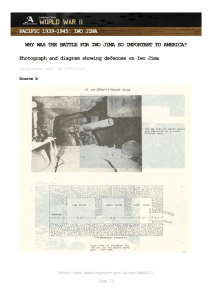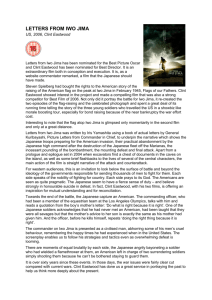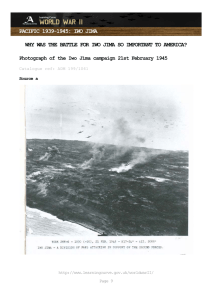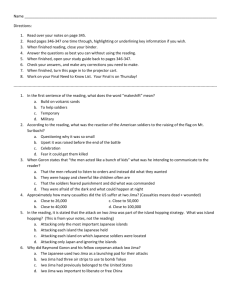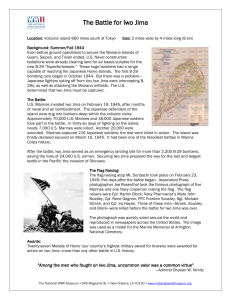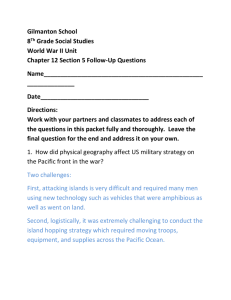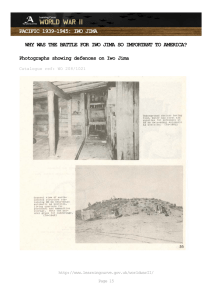PACIFIC 1939-1945: IWO JIMA
advertisement
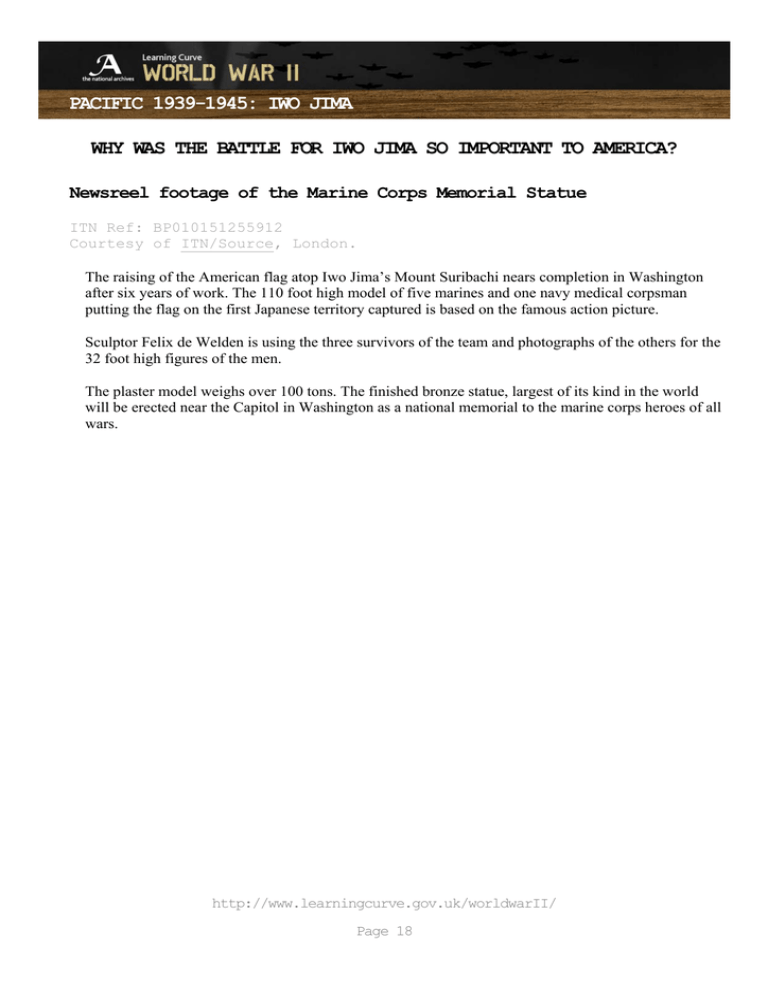
PACIFIC 1939-1945: IWO JIMA WHY WAS THE BATTLE FOR IWO JIMA SO IMPORTANT TO AMERICA? Newsreel footage of the Marine Corps Memorial Statue ITN Ref: BP010151255912 Courtesy of ITN/Source, London. The raising of the American flag atop Iwo Jima’s Mount Suribachi nears completion in Washington after six years of work. The 110 foot high model of five marines and one navy medical corpsman putting the flag on the first Japanese territory captured is based on the famous action picture. Sculptor Felix de Welden is using the three survivors of the team and photographs of the others for the 32 foot high figures of the men. The plaster model weighs over 100 tons. The finished bronze statue, largest of its kind in the world will be erected near the Capitol in Washington as a national memorial to the marine corps heroes of all wars. http://www.learningcurve.gov.uk/worldwarII/ Page 18 PACIFIC 1939-1945: IWO JIMA What is this source? This is an American newsreel that was broadcast in 1951. British audiences would have also seen it. The sculptor of the statue, Felix de Weldon based his work on the famous picture by Joe Rosenthal that you can see at the opening of this investigation. The men shown in the statue were famous in the months after Iwo Jima because the government used them in a campaign to raise money for the war effort. In 1951 US Marines were back in action, this time in Korea. They were fighting against the forces of North Vietnam that had invaded America’s ally South Vietnam. What's the background to this source? During the 1930s Japan emerged as a major world power. It had ambitions to build a great empire in Asia and the Pacific. To do this Japan would have to defeat the USA, and in December 1941 Japanese forces attacked and sank the US Pacific fleet in Pearl Harbor, Hawaii. Japanese successes continued into 1942 until May of that year when US forces destroyed Japan’s aircraft carriers at the Battle of Midway. From this point the USA gradually drove Japanese forces back. By 1945 US forces reached the first of the islands that made up Japan’s homelands - Iwo Jima. The attack began on February 19th 1945. The Japanese plan was to cause as many casualties as possible to the invading Americans. The troops and their commander knew their role was to delay the Americans while their comrades prepared to defend the rest of Japan. It was effectively a suicide mission. Iwo Jima was heavily defended by over 20 000 troops with plenty of artillery and other equipment. They were dug into a system of caves and bunkers. They fought ferociously. When the battle ended on March 16th 1945 US casualties totalled almost 28 000 (with over 8000 dead). Japanese casualties were almost 21 000 dead out of a force of 22 000. Those not killed in fighting committed suicide. It's worth knowing that... The American film star John Wayne made a film called the Sands of Iwo Jima in 1949. This was very patriotic and glorified the campaign. It is said to have inspired many young Americans to join the Marines during the war in Korea 1950-53. By contrast, the 2006 film Flags of Our Fathers by Hollywood director Clint Eastwood was more realistic and focused more on the human experience of the battle. http://www.learningcurve.gov.uk/worldwarII/ Page 19 PACIFIC 1939-1945: IWO JIMA Eastwood was so inspired by his research for the film that he decided to make another film about Iwo Jima called Letters From Iwo Jima. This was filmed in Japanese and presented the Japanese point of view. How will you use this source? 1. 2. 3. 4. Describe the statue shown in the clip How can you tell Americans are proud of this statue? What does this film tell us about the importance of Iwo Jima to Americans? Is there any information from the source or notes that you could use in your presentation? http://www.learningcurve.gov.uk/worldwarII/ Page 20

